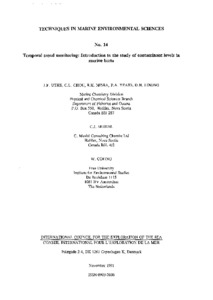| dc.contributor.author | Uthe, J. F. | |
| dc.contributor.author | Chou, C. L. | |
| dc.contributor.author | Misra, R. K. | |
| dc.contributor.author | Yeats, P. A. | |
| dc.contributor.author | Loring, D. H. | |
| dc.contributor.author | Musial, C. J. | |
| dc.contributor.author | Cofino, W. | |
| dc.date.accessioned | 2019-01-15T23:37:04Z | |
| dc.date.available | 2019-01-15T23:37:04Z | |
| dc.date.issued | 1991 | |
| dc.identifier.citation | Uthe, J. F.; Chou, C.L.; Misra, R.K.; Yeats, P.A.; Loring, D.H.; Musial, C.J. and Cofino, W. (1991) Temporal trend monitoring: Introduction to the study of contaminant levels in marine biota. ICES Techniques in Marine Environmental Sciences, No. 14, 18pp. DOI: http://dx.doi.org/10.25607/OBP-250 | en_US |
| dc.identifier.issn | 0903–2606 | |
| dc.identifier.uri | http://hdl.handle.net/11329/693 | |
| dc.identifier.uri | http://dx.doi.org/10.25607/OBP-250 | |
| dc.description.abstract | The
study
of
contaminants
in
marine
species,
sediments,
and
sea
water
has
been
of
interest
to
the
International
Council
for
the
Exploration
of
the
Sea
(ICES)
since
the
early
1970s.
The
investigation
of
temporal
trends
(changes
over
time
in
one
area)
in
contaminant
levels
in
fish
and
shellfish,
both
as
monitors
of
their
environment
and
from
a human
health
concern,
and
in
sediments
and
sea
water
is
3
topic
currently
being
addressed
by
the
ICES
Working
Group
on
the
Statistical
Aspects
of
Trend
Monitoring
(WGSATM).
In
this
connection,
the
following
two
points
should
be
noted:
a)
The
design
of
a monitoring
programme
is
a scientific
effort,
in
which
expertise
in
the
fields
of
biology,
environmental
and
analytical
chemistry,
statistics,
and
hydrography
must
be
combined,
utilizing
specific
information
on
the
area
to
be
monitored.
It
is not
possible
to
give
a simple
blueprint
for
the
design
of
these
prograntrnes.
Rather,
each
study
must
be
specifically
designed
within
the
general
strategies
and
guidelines
such
as
those
provided
by
the
ICES
Advisory
Committee
on
Marine
Pollution
(ACMP)
(ICES,
1989a,b).
b)
The
objectives
of
the
monitoring
programme
have
to
be
defined
qualitatively
and
quantitatively.
Statistical
model
calculations
based
upon
real
estimates
of
the
overall
variance
are
a prerequisite
to
programme
design,
to
give
insight
into
the
resolving
power
of
the
approach.
In
most
cases,
conduct
of
a "pilot
project"
will
be
necessary
during
the
design
of
a programme. | |
| dc.language.iso | en | en_US |
| dc.publisher | International Council for the Exploration of the Sea (ICES) | en_US |
| dc.relation.ispartofseries | ICES Techniques in Marine Environmental Sciences; 14 | |
| dc.title | Temporal trend monitoring: Introduction to the study of contaminant levels in marine biota. | en_US |
| dc.type | Report | en_US |
| dc.description.status | Published | en_US |
| dc.format.pages | 18pp. | en_US |
| dc.description.refereed | Refereed | en_US |
| dc.publisher.place | Copenhagen, Denmark | en_US |
| dc.description.currentstatus | Current | en_US |
| dc.description.sdg | 14.1 | |
| dc.description.bptype | Standard Operating Procedure | en_US |
| dc.description.bptype | Guide | en_US |
| obps.contact.contactemail | info@ices.dk | |
| obps.resourceurl.publisher | http://ices.dk/publications/library/ | en_US |
 Repository of community practices in Ocean Research, Applications and Data/Information Management
Repository of community practices in Ocean Research, Applications and Data/Information Management
